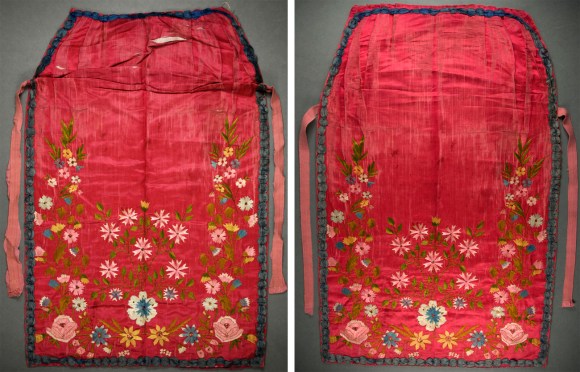Η διακοσμημένη με φυτικά θέματα μεταξωτή ποδιά είχε υποστεί αποδυνάμωση των ινών και απώλεια της συνοχής του υφάσματος και έφερε πολλαπλές τσακίσεις εξαιτίας του ακατάλληλου, κατά το παρελθόν, τρόπου αποθήκευσής της. Στις θέσεις στερέωσης των ταινιών πρόσδεσης διαπιστώθηκε η ύπαρξη παλαιότερης επέμβασης, η οποία είναι πιθανό να αποσκοπούσε στην τροποποίηση των διαστάσεών της ποδιάς. Η επιφάνεια καθαρίστηκε πρώτα μηχανικά, με χρήση ηλεκτρικής σκούπας (vacuum cleaning), ρυθμιζόμενης έντασης απορρόφησης, στην οποία είχαν προσαρμοστεί ειδικά ακροφύσια. Στις ταινίες πρόσδεσης, αφού αποσυνδέθηκαν από την ποδιά, έγινε υγρός καθαρισμός και επιπεδοποίηση, ενώ η ίδια εργασία για το κεντρικό τμήμα της ποδιάς έγινε στις θέσεις των τσακίσεων και των φθορών με ελεγχόμενη εφαρμογή ατμού (Ultrasonic Humidifier). Η μερική αποσύνδεση τμήματος κατά μήκος του άνω άκρου της ποδιάς ήταν απαραίτητη προκειμένου να εξασφαλιστεί η πρόσβαση στην πίσω πλευρά του μεταξωτού υφάσματος. Μέσω του ανοίγματος που δημιουργήθηκε τοποθετήθηκαν, ανάμεσα στην μεταξωτή πρόσοψη και στην βαμβακερή φόδρα, κατάλληλα προετοιμασμένα μεταξωτά υφάσματα υποστήριξης τα οποία στερεώθηκαν περιμετρικά, στην πίσω πλευρά του μεταξωτού υφάσματος, με μονόκλωνη μεταξωτή κλωστή βαμμένη, με βαφές Ciba-Geigy, στην κατάλληλη απόχρωση. Ακολούθησε η σύνδεση του άνω άκρου της ποδιάς και η επανατοποθέτηση των ταινιών πρόσδεσης.
This beautiful, decorated with floral motifs silk apron, had suffered heavily due to inappropriate storage. The silk threads had lost their strength and signs of wear were obvious in many areas. Rough folding had also lead to the formation of numerous creases. An old intervention was recorded along the top edge; where the straps were sewn onto the apron and it is presumed that this was done at some point, in order to modify the size of the garment. Accumulated dirt was removed from both sides of the apron using a vacuum of adjustable suction force, mounted with suitable nozzles. The straps were then removed, washed and flattened separately. Worn areas and creases were flattened by means of an Ultrasonic Humidifier providing controlled steam. Access to the reverse side of the silk fabric was considered necessary in order to sufficiently support the worn areas and for this to be achieved, the upper edge of the apron was partially unstitched. Appropriately prepared silk pieces of fabric were used as support. They were inserted between the front, silk part of the apron and the cotton lining, and sewn onto the back of the front piece using silk, single thread, yarns which had first been colored to match the fabric, using Ciba – Geigy textile dyes. Finally the opening along the top part of the apron was closed and the straps were stitched back into place.




Πρέπει να έχετε συνδεθεί για να σχολιάσετε.